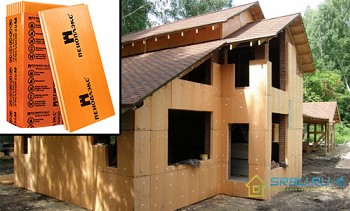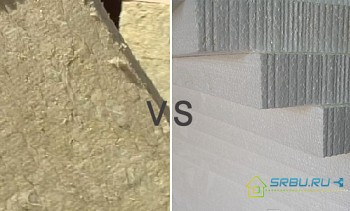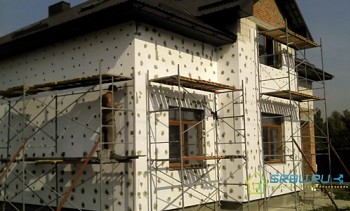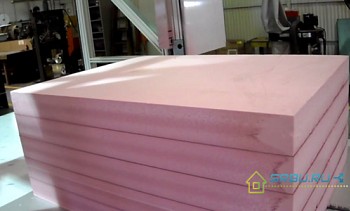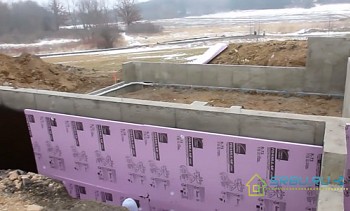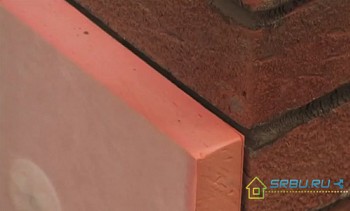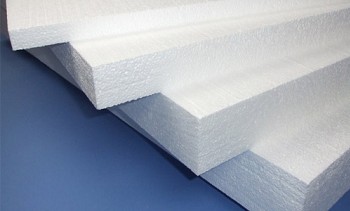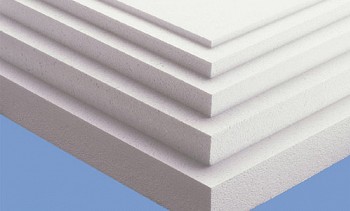Low density and light weight, excellent thermal performance and good sound insulation make foam one of the most popular heat-insulating materials. Modern technologies allow the production of various types of foam, which differ in characteristics, cost and purpose. Knowing the differences will help you choose the best material for various jobs.
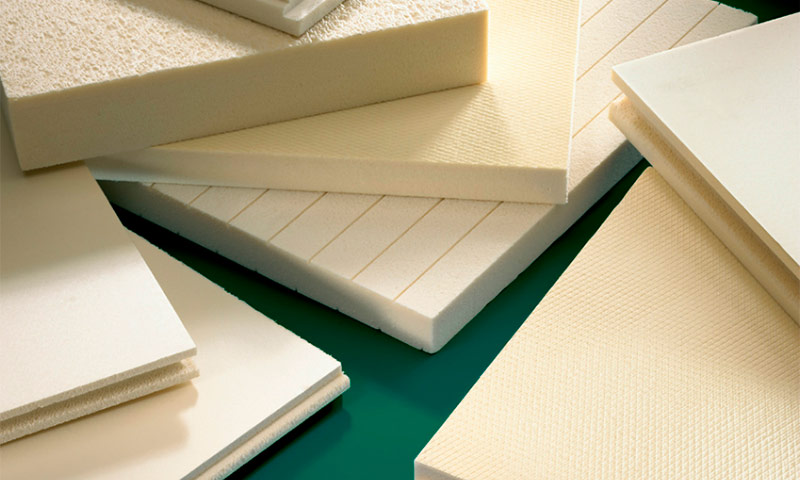
- The difference in foam by manufacturing methods
- Types of expanded polystyrene foam - EPS
- Grades and types of expanded polystyrene foam in density
- Plates of expanded polystyrene foam, depending on the manufacturing technology
- Styrofoam plates depending on the shape of the plate
- Dimensions of expanded polystyrene foam boards
- Example and interpretation of the symbol for expanded polystyrene boards
- Types of extruded polystyrene foam - XPS
The difference in foam by manufacturing methods
Before we begin to consider the types of polystyrene, it is necessary to clarify the terminology. Many people call polyfoam a light white material consisting of a huge number of white pressed balls, in general this is true, but one point needs to be clarified.
Polyfoam is a common name for a whole group of materials obtained by foaming plastics. Since various plastics can be foamed, there is a huge amount of foams. For example, if polystyrene is used as a raw material - polystyrene material is obtained, if polyurethane is used as a raw material - polyurethane foam is obtained (polyurethane foam is one of the types), polyvinyl chloride foam is obtained from polyvinyl chloride.
The production technology for all foams consists of three main stages:
- Mixing used components.
- Foaming.
- Structuring.
The main technological link is foaming, at this stage gas filling of polymers occurs, which determines the technical characteristics of the material.
An important role on the physicomechanical properties of the foam is provided by the ratio between open and closed cells with air. Closed cells guarantee low hygroscopicity. The less foam absorbs water, the better its thermal performance, the longer the material.
The structure of the foam depends on the manufacturing technology and the raw materials used. A large number of closed cells in polystyrene foam, polyurethane and polyvinyl chloride.
According to the production technology, two main types of expanded polystyrene are distinguished:
- expanded polystyrene foam - (EPS)
- extruded polystyrene foam - (XPS).
Expanded polystyrene foam - (EPS)
Most often, foamed polystyrene foam is used in everyday life. It is used as thermal insulation, material for packaging appliances and furniture. In its manufacture, gas filling of polymers is carried out using foaming components.

Expanded polystyrene foam.
The technological chain consists of several stages:
- Mixing polystyrene, which is sometimes replaced by polymonochlorostyrene or polydichlorostyrene.
- The addition of foaming components, which include low-boiling hydrocarbons - dichloromethane, pentane or isopentane.
- Adding additives that improve the properties of the finished material - plasticizers, flame retardants and dyes.
- The formation of granules with a uniform distribution of boiling liquids in polystyrene.
- Steam or hot air.
- The increase in granules in size as a result of the sharp evaporation of low-boiling liquids.
- Structuring of the cells of the foam, giving it shape.
As a result of the boiling of the foaming components, the granules increase in size by more than 50 times. The walls of the forming cells harden and merge, closing the air inside - an ideal heat insulator. The material is lightweight, homogeneous, well retains its faithful shape.

Expanded polystyrene foam granules in enlarged form.
Extruded Expanded Polystyrene - (XPS)
The main differences in the technology for the production of extruded polystyrene foam are the lack of steam treatment and structuring by extrusion from a flat slot extrusion head. In the first decades of the production of the material, freons were used as a blowing agent, today carbon dioxide is used.
This polystyrene foam has a continuous structure with closed-cell cells with a diameter of 0.1 - 0.2 mm.

Extruded polystyrene foam.
Extruded polystyrene foam has good thermal insulation properties while it has a higher density than expanded polystyrene foam. This allows the use of extruded polystyrene foam to insulate those objects for which expanded polystyrene foam is too soft. It is possible to manufacture extruded polystyrene foam, which will withstand a load of up to 35 tons per 1 m2.
Types of expanded polystyrene foam - EPS
The classification of expanded polystyrene foam is based on:
- density;
- manufacturing technology;
- plate shape.
Grades and types of expanded polystyrene foam in density
Depending on the density limit value, expanded polystyrene foam is divided into grades.
The following types of this foam are produced in density:
| Styrofoam grade | The minimum density value, kg / m3. | Thermal conductivity of the material in a dry state, at a temperature of (25 ± 5) 0C, W / (m * K) |
|---|---|---|
| PPS10 | 10 | 0,044 |
| PPS12 | 12 | 0,042 |
| PPS13 | 13 | 0,041 |
| PPS14 | 14 | 0,040 |
| PPS16F | 16 | 0,038 |
| PPS17 | 17 | 0,039 |
| PPS20 | 20 | 0,038 |
| PPS23 | 23 | 0,037 |
| PPS25 | 25 | 0,036 |
| PPS30 | 30 | 0,037 |
| PPS35 | 35 | 0,038 |
Plates of expanded polystyrene foam, depending on the manufacturing technology
Depending on the manufacturing technology, the following types of expanded polystyrene are produced:
- P - produce by cutting from large blocks;
- RG - cut graphite-containing from large blocks;
- T - thermoformed.
Styrofoam plates depending on the shape of the plate
Depending on the shape of the foam plate, two types are available:
BUT - chopped slabs having a solid straight side edge.

B - chopped or molded slabs having a quarter edge selected for easier and more efficient installation.

Dimensions of expanded polystyrene foam boards
Modern technologies allow the production of expanded polystyrene plates of various sizes. According to GOST, the length of the plates varies from 500 to 6000 mm in increments of 50 mm, and the width - from 500 to 2000 mm in increments of 50 mm. The foam thickness is from 10 to 500 mm in increments of 5 mm.
Example and interpretation of the symbol for expanded polystyrene boards
To understand the specifics of expanded polystyrene foam boards allows marking, which indicates not only the overall dimensions, but also the type of material, the type of edge.
In the symbol, it is possible to indicate special characteristics, for example, the color of the foam or brand. Also, the GOST must be indicated in the marking, in accordance with which the material is produced.
An example of decoding symbols:
PPS16F-R-A-2000x1000x150 GOST 15588-2014
- polystyrene foam for facade systems (PPS16F);
- density - 16 kg / cubic meter. (PPS16F);
- produced by cutting from large blocks (P);
- has a solid, straight side edge (A);
- length - 2000 mm;
- width - 1000 mm;
- thickness - 150 mm;
- made in accordance with GOST 15588-2014.
Decoding of the marking allows you to make sure that the material is suitable for the planned work.
Types of extruded polystyrene foam - XPS
GOST has not been developed for extruded polystyrene foam, for this reason manufacturers produce plates with those dimensions and properties that they consider relevant for their potential customers. The material of different brands differs in colors, which is one of the hallmarks of the brand.
Types of extruded polystyrene foam depending on density
Depending on the density of the plate, XPS is divided into three main types:
Type 30 - have a density of 25-30 kg / cubic meter., Strength characteristics allow the use of material for insulation of pitched roofs, facades, foundations, underground utilities.
Type 35 - have a density of 28-38 kg / cubic meter., Flame retardant additives are used in the production, which makes the material resistant to fire and relevant for the insulation of external walls, partitions, floors and floors.
Type 45 - the density of the material is 38-45 kg / m3, have high strength and are used in the construction of highways, runways, foundations of high-rise buildings.
Some manufacturers produce materials with a higher or lower density, but the types listed above are most popular.
Extruded polystyrene foam plates depending on the shape
XPS boards are produced by extrusion through a gap of a certain shape, this allows you to produce polystyrene boards with various shapes.
1. Plates with a straight straight edge.

2. Stepped edge slabs with a quarter notch.

3. Plates with a tongue-and-groove edge.

4. Plates with embossed surface.

The presence of a complex shape of the edge simplifies installation, improves the tightness of the constructed thermal insulation layer. The relief surface has a higher adhesion to the plaster.
All types of XPS are characterized by low water absorption, as they have dense closed cells. This is a guarantee of a long service life and preservation of thermal performance.

